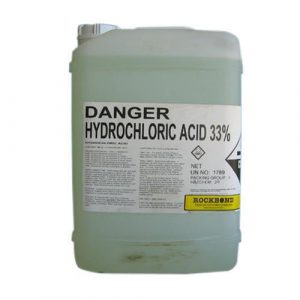Hydrochloric acid 33%

Hydrochloric acid 33% is a colorless inorganic acid with a pungent smell and generates fumes. It is classified as a strong acid and can attack the skin. It has a pH of 1, specific gravity of 1.16 and is highly soluble in water. It reacts violently with alkali metals to liberate the extremely flammable hydrogen gas.
Hydrochloric acid is used in the production of batteries, photoflash bulbs and fireworks. It’s also used to process sugar and make gelatin and in food and beverage industries.
Applications:
Hydrochloric acid is a strong inorganic acid that is used in many industrial processes such as refining metal. The application often determines the required product quality.[19] Hydrogen chloride, not hydrochloric acid, is used more widely in industrial organic chemistry, e.g. for vinyl chloride and dichloroethane.
Laboratory use
Of the six common strong mineral acids in chemistry, hydrochloric acid is the monoprotic acid least likely to undergo an interfering oxidation-reduction reaction. It is one of the least hazardous strong acids to handle; despite its acidity, it contains the non-reactive and non-toxic chloride ion. Intermediate-strength hydrochloric acid solutions are quite stable upon storage, maintaining their concentrations over time. These attributes, plus the fact that it is available as a pure reagent, make hydrochloric acid an excellent acidifying reagent. It is also inexpensive.
Hydrochloric acid is the preferred acid in titration for determining the amount of bases. Strong acid titrants give more precise results due to a more distinct endpoint. Azeotropic, or “constant-boiling”, hydrochloric acid (roughly 20.2%) can be used as a primary standard in quantitative analysis, although its exact concentration depends on the atmospheric pressure when it is prepared.

